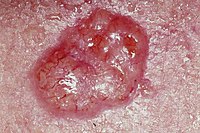
Enzyme-digested Colla Corii Asini (E’jiao) accelerates wound healing and prevents ultraviolet A-induced collagen synthesis decline and wrinkle formation in three-dimensional skin equivalents
Sign Up to like & getrecommendations! Published in 2020 at "Human Cell"
DOI: 10.1007/s13577-020-00405-y
Abstract: Cutaneous wound healing delay, collagen synthesis decline and wrinkle formation are the common features of skin aging. The aim of this study is to investigate repressive effects of Colla Corii Asini (CCA) (a traditional Chinese… read more here.
Keywords: wound healing; ccad; formation; skin equivalents ... See more keywords

Human skin equivalents: impaired barrier function in relation to the lipid and protein properties of the stratum corneum.
Sign Up to like & getrecommendations! Published in 2021 at "Advanced drug delivery reviews"
DOI: 10.1016/j.addr.2021.05.012
Abstract: To advance drug development representative reliable skin models are indispensable. Animal skin as test model for human skin delivery is restricted as their properties greatly differ from human skin. In vitro 3D-human skin equivalents (HSEs)… read more here.
Keywords: equivalents impaired; skin; human skin; skin equivalents ... See more keywords

Development of wrinkled skin-on-a-chip (WSOC) by cyclic uniaxial stretching
Sign Up to like & getrecommendations! Published in 2018 at "Journal of Industrial and Engineering Chemistry"
DOI: 10.1016/j.jiec.2018.07.050
Abstract: Abstract The skin experiences constant physical stimuli, such as stretching. Exposure to excessive physical stimuli stresses the skin and can accelerate aging. In this study, we applied a method that allowed human fibroblasts and keratinocytes… read more here.
Keywords: wrinkled skin; skin equivalents; skin chip; uniaxial stretching ... See more keywords

Preclinical Testing of Dendritic Core-Multishell Nanoparticles in Inflammatory Skin Equivalents.
Sign Up to like & getrecommendations! Published in 2022 at "Molecular pharmaceutics"
DOI: 10.1021/acs.molpharmaceut.1c00734
Abstract: Human skin equivalents emerged as novel tools in preclinical dermatological research. It is being claimed that they may bridge the translational gap between preclinical and clinical research, yet only a few studies have investigated their… read more here.
Keywords: core multishell; skin equivalents; dendritic core; inflammatory skin ... See more keywords

Automated epidermal thickness quantification of in vitro human skin equivalents using optical coherence tomography.
Sign Up to like & getrecommendations! Published in 2022 at "BioTechniques"
DOI: 10.2144/btn-2021-0123
Abstract: Human skin equivalents (HSEs) are in vitro models of human skin. They are used to study skin development, diseases, wound healing and toxicity. The gold standard of analysis is histological sectioning, which both limits three-dimensional assessment… read more here.
Keywords: skin; skin equivalents; human skin; epidermal thickness ... See more keywords

Effect of α-Lipoic Acid on the Development of Human Skin Equivalents Using a Pumpless Skin-on-a-Chip Model
Sign Up to like & getrecommendations! Published in 2021 at "International Journal of Molecular Sciences"
DOI: 10.3390/ijms22042160
Abstract: Owing to the prohibition of cosmetic animal testing, various attempts have recently been made using skin-on-a-chip (SOC) technology as a replacement for animal testing. Previously, we reported the development of a pumpless SOC capable of… read more here.
Keywords: ala; human skin; skin; skin equivalents ... See more keywords

Advanced Online Monitoring of In Vitro Human 3D Full-Thickness Skin Equivalents
Sign Up to like & getrecommendations! Published in 2022 at "Pharmaceutics"
DOI: 10.3390/pharmaceutics14071436
Abstract: Skin equivalents and skin explants are widely used for dermal penetration studies in the pharmacological development of drugs. Environmental parameters, such as the incubation and culture conditions affect cellular responses and thus the relevance of… read more here.
Keywords: skin; skin equivalents; thickness skin; full thickness ... See more keywords